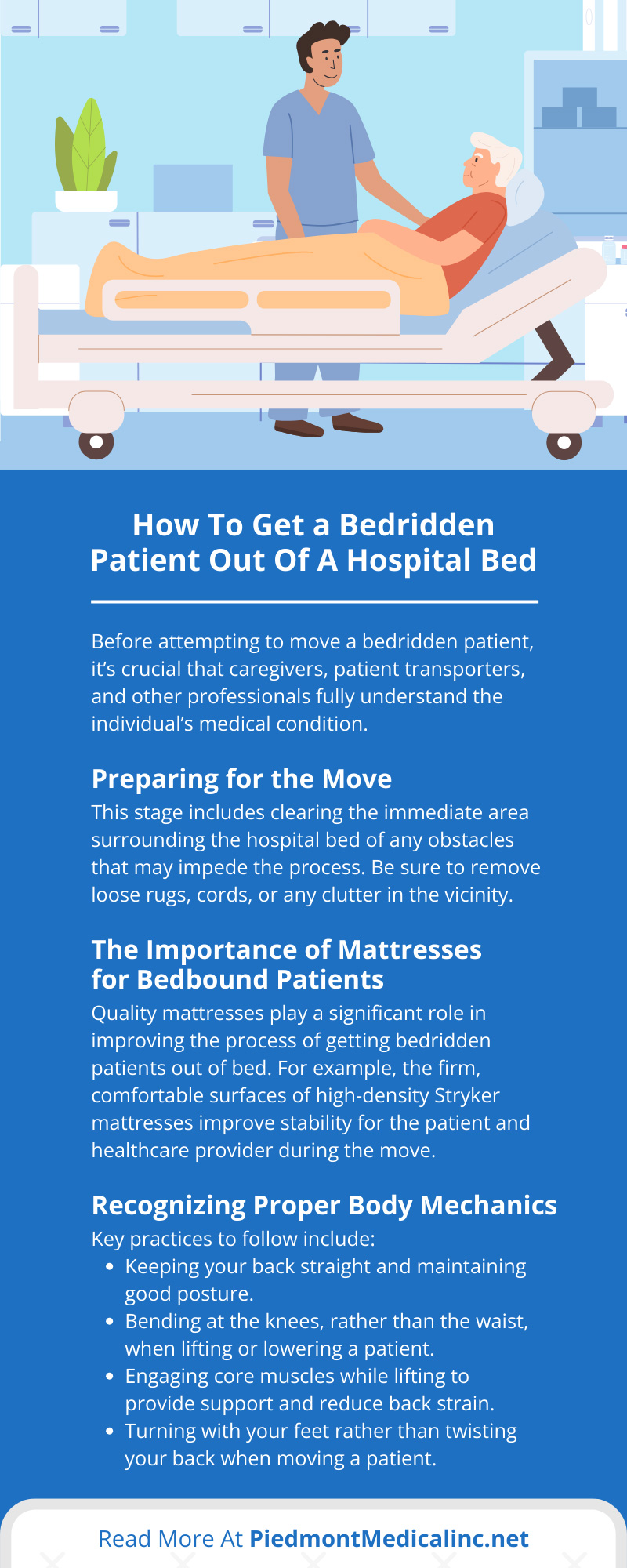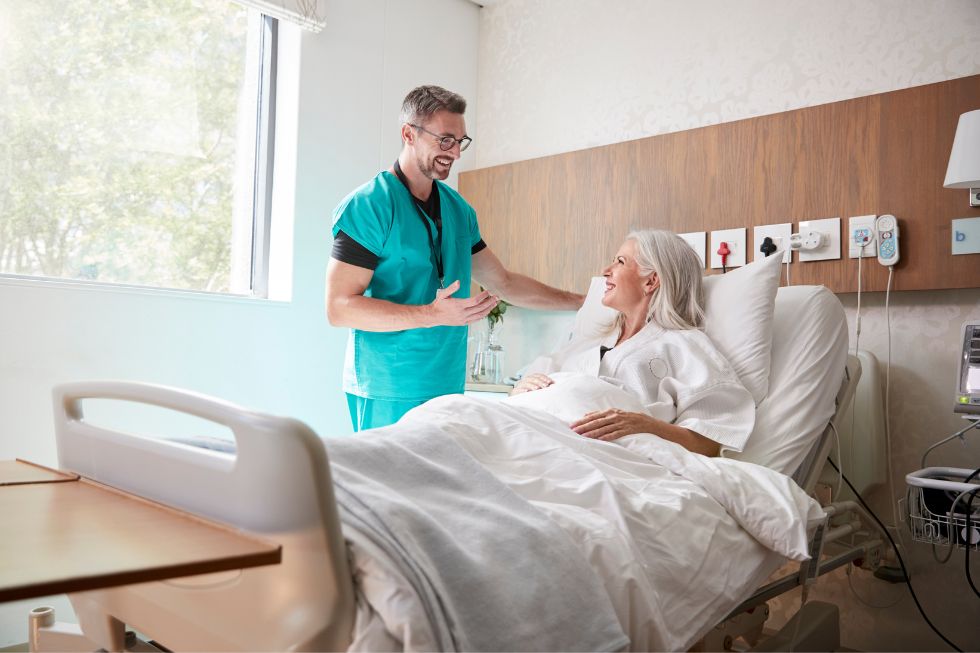Caring for bedridden or bedbound patients requires a profound understanding of their specific needs and demands. These patients, due to various health conditions, are unable to move freely and are primarily confined to their beds, necessitating special care and attention.
Healthcare staff are essential in ensuring bedbound patients’ well-being, comfort, and quality of life. Among the many responsibilities, one of the most vital tasks is knowing how to get a bedridden patient out of a hospital bed safely. Explore this critical aspect of patient care to understand transfer techniques, the use of assistive devices, and the importance of correct body mechanics.
Understanding the Patient’s Condition
Before attempting to move a bedridden patient, it’s crucial that caregivers, patient transporters, and other professionals fully understand the individual’s medical condition. Each patient’s needs and requirements will differ depending on factors such as age, mobility, pain levels, and the severity of their condition.
By becoming familiar with the patient’s specific situation and their physical support requirements and limitations, caregivers can better adjust their handling techniques to ensure a safe and comfortable move. For instance, a patient with severe arthritis may have limited joint movement and might require careful handling and additional padding during the transfer to prevent discomfort or injury.
In the case of individuals recovering from a stroke, one side of their body could be weaker, necessitating a more supportive transfer technique and possibly the use of assistive equipment. Similarly, a patient with a spinal cord injury would require a completely different approach, including strict immobilization, to avoid exacerbating their condition during the transfer process.
Preparing for the Move
Preparing for the move is an essential step in getting a bedridden patient out of a hospital bed. This stage includes clearing the immediate area surrounding the hospital bed of any obstacles that may impede the process. Be sure to remove loose rugs, cords, or any clutter in the vicinity.
Next, talk through the moving process with the patient. Explain what is going to happen and the steps involved, which can help alleviate any fear or anxiety they may have. Ensure they are comfortable before starting the move, and consider providing additional support with pillows or cushioning if necessary.
The Importance of Mattresses for Bedbound Patients
Quality mattresses play a significant role in improving the process of getting bedridden patients out of bed. For example, the firm, comfortable surfaces of high-density Stryker mattresses improve stability for the patient and healthcare provider during the move.
These beds also support the overall health of bedbound patients. Pressure-relieving mattresses can prevent or reduce the incidence of bed sores by distributing the patient’s weight evenly across the surface, reducing pressure points.
Recognizing Proper Body Mechanics
Body mechanics principles help caregivers prevent injuries to themselves or the patient during the moving process. Key practices to follow include:
- Keeping your back straight and maintaining good posture.
- Bending at the knees, rather than the waist, when lifting or lowering a patient.
- Engaging core muscles while lifting to provide support and reduce back strain.
- Turning with your feet rather than twisting your back when moving a patient.
Consequences of Unsafe Transfer Techniques
Failure to apply proper body mechanics when moving a patient can have severe repercussions. For the caregiver, this can lead to musculoskeletal injuries such as strains or sprains, particularly affecting the back, neck, or shoulders due to improper lifting or twisting motions.
For the patient, improper handling can result in discomfort, injury, or exacerbation of existing conditions, posing serious risks to their overall health and well-being. By adhering to these principles, caregivers can ensure a safer and more effective moving process for both themselves and patients.
Using Hospital Bed Controls
Another important aspect of patient mobility is the use of hospital bed controls. These controls allow caregivers to adjust the bed’s height and angle, making it easier and safer to move the patient. Understanding how to operate these controls prevents injury and facilitates a smooth transition.
For example, raising the bed’s height to an appropriate level for the caregiver can reduce strain on their back and minimize the risk of injury. Adjusting the angle of the bed can also help the patient shift their weight more easily, simplifying the moving process.
Understanding the Role of Assistive Devices
Assistive devices can play a significant role in transferring patients. Transfer belts, for example, wrap securely around the patient’s waist, allowing the caregiver to maintain a stable grip while assisting with the transfer.
Slide boards provide a smooth, hard surface that bridges the gap between two points, such as between a bed and a wheelchair. By reducing friction, slide boards make it easier for caregivers to slide patients across rather than lifting them.
When used correctly, these devices make the transfer process more manageable, promote safety, and reduce the risk of injury to both parties. It is imperative, however, to properly understand and practice the use of these devices prior to their application.
Performing Post-Move Comfort and Safety Checks
After successfully transferring the patient, perform a series of comfort and safety checks. Ensure the patient’s proper positioning in their new location, whether it’s a wheelchair or another surface, and adjust as needed for maximum comfort.
Look for any signs of discomfort or distress the patient may exhibit, then reposition or otherwise assist them if necessary. Verbal complaints of pain or discomfort and difficulty maintaining an upright position clearly indicate a need for repositioning or applying more support.
The following are additional signs of patient discomfort that may indicate a need for further adjustment:
- Grimacing or wincing
- Excessive sweating
- Rapid or shallow breathing
- Changes in body language, such as protective posturing
- Unusual restlessness or agitation
Knowing the Importance of Regular Practice
Becoming proficient in getting a bedridden patient out of a hospital bed requires regular practice, not only to develop proper techniques but also to gain confidence in performing these moves. Familiarize yourself with the various applicable methods and assistive devices at your disposal. Developing the skillset to execute these transfers safely and effectively is fundamental for patient care.
Safely moving a bedbound patient requires a comprehensive understanding of the patient’s condition, careful preparation, correct body mechanics, and effective use of assistive devices and hospital bed controls. Regular practice and observance of safety protocols prevent injuries and ensure comfort for both caregiver and patient. By following the guidelines outlined above, healthcare teams can provide their patients with a higher quality of care, ensuring their safety, comfort, and overall well-being.\



Recent Comments